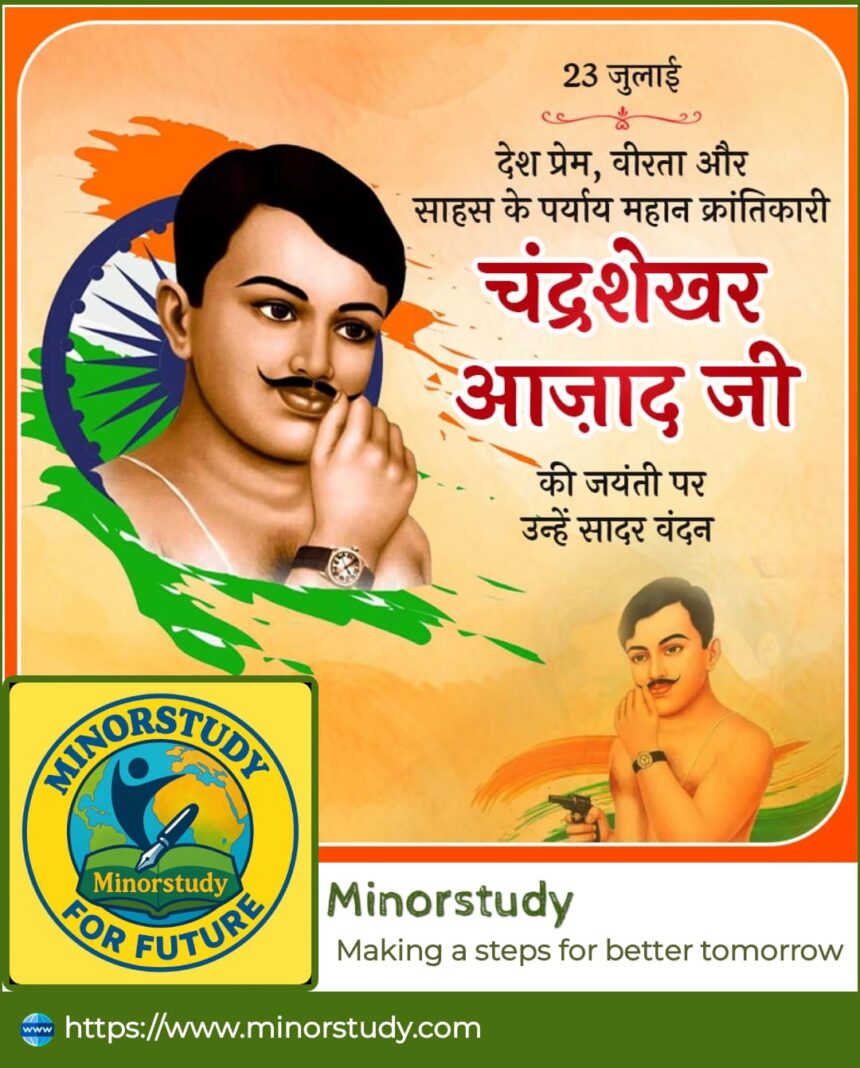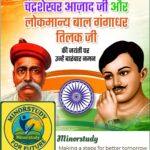🕊️ 7 Unbreakable Facts About Chandrashekhar Azad That Prove His Fearless Legacy
Chandrashekhar Azad is not just a name—it is a symbol of undying courage, fierce nationalism, and unyielding resistance against British colonialism. His life was a thunderbolt of inspiration in India’s freedom struggle, igniting a sense of rebellion among thousands of young Indians. From his early years to his final sacrifice in Allahabad, Azad’s story is one of passion, pain, and patriotism.
- 📖 History of Chandrashekhar Azad: The Boy Who Became “Azad”
- 🔥 7 Powerful and Lesser-Known Facts About Chandrashekhar Azad
- 🕰️ Timeline of Chandrashekhar Azad’s Revolutionary Life
- 💡 Significance of Chandrashekhar Azad in Indian Freedom Struggle
- 🙏 Observing and Honoring Azad’s Legacy
- 💬 Heartfelt Wishing Messages for Azad’s Birth Anniversary
- ❓ Frequently Asked Questions (FAQs)
- Q1. Why is Chandrashekhar Azad called ‘Azad’?
- Q2. Who were Azad’s associates in the freedom struggle?
- Q3. Did Chandrashekhar Azad believe in Gandhi’s ideology?
- Q4. Where is Chandrashekhar Azad’s memorial?
- Q5. What is the impact of Azad’s legacy on today’s youth?
- 🔍 Important Points to Remember
- 🌍 Importance of Chandrashekhar Azad in Daily Life and Society
- 🧠 Conclusion: Why Chandrashekhar Azad Still Matters
- ✅ Final Thought:
In this article, we dive deep into the history, facts, FAQs, timeline, significance, wishing messages, observance ideas, and most importantly, how Chandrashekhar Azad’s legacy continues to impact our daily lives. Written with human emotion and understanding, let’s explore how one man reshaped the course of India’s history.
📖 History of Chandrashekhar Azad: The Boy Who Became “Azad”
Born on 23 July 1906 in Bhavra, a tribal village in Madhya Pradesh, Chandrashekhar Tiwari (his birth name) grew up in a deeply patriotic household. His mother wanted him to become a Sanskrit scholar, and so he was sent to Kashi Vidyapeeth in Varanasi, but destiny had other plans.
In 1921, at the age of just 15 years, he joined the Non-Cooperation Movement launched by Mahatma Gandhi. Despite his age, he was arrested for his participation. When the magistrate asked his name, he confidently replied:
“Azad” (Free)
Father’s name: “Swatantrata” (Freedom)
Residence: “Jail”
From that day on, Chandrashekhar Tiwari became Chandrashekhar Azad, a name that would echo through the chambers of Indian history.
🔥 7 Powerful and Lesser-Known Facts About Chandrashekhar Azad
Youngest Revolutionary: Azad joined the freedom movement at the age of just 15—one of the youngest to do so.
Master of Guerrilla Warfare: He was an expert in guerrilla tactics, which helped him evade the British police multiple times.
Self-Taught Marksman: He trained himself in marksmanship using a Mauser pistol, becoming one of the best shooters in the Hindustan Socialist Republican Association (HSRA).
Mentor to Bhagat Singh: Azad played a major role in mentoring Bhagat Singh and inspired many young revolutionaries.
Never Caught Alive: He vowed he would never be taken alive by the British, and he kept his promise.
Lived in Disguise: For years, he lived under different names and identities, even working as a priest in disguise.
Died with a Smile: On 27 February 1931, when surrounded by British police in Alfred Park (now Azad Park), he shot himself with his last bullet—choosing death over capture.
🕰️ Timeline of Chandrashekhar Azad’s Revolutionary Life
| Year | Milestone |
|---|---|
| 1906 | Born in Bhavra, Madhya Pradesh |
| 1921 | Joins Non-Cooperation Movement |
| 1922 | Arrested and renamed himself ‘Azad’ |
| 1924 | Joins Hindustan Republican Association (HRA) |
| 1928 | Reorganizes it into Hindustan Socialist Republican Association (HSRA) with Bhagat Singh |
| 1928 | Involved in killing J.P. Saunders (in retaliation of Lala Lajpat Rai’s death) |
| 1930 | Stays underground, planning further revolts |
| 1931 | Martyred in Alfred Park, Allahabad |
💡 Significance of Chandrashekhar Azad in Indian Freedom Struggle
Chandrashekhar Azad was a revolutionary in the truest sense. While Gandhi’s non-violence mobilized the masses, Azad and his peers believed in action through revolution. He balanced ideology with intense nationalism, believing in complete independence, not just dominion status under the British Crown.
His contribution lies in:
Organizing the youth for an armed struggle.
Reviving the spirit of resistance when many were disheartened.
Inspiring next-generation revolutionaries like Bhagat Singh, Rajguru, Sukhdev, and others.
Laying down a framework of patriotism that included sacrifice, intelligence, and courage.
🙏 Observing and Honoring Azad’s Legacy
Each year, 23rd July (his birth anniversary) and 27th February (his death anniversary) are marked by tributes in various parts of India.
Ways to observe:
School and college tributes: Essay, speech, and drawing competitions.
Public readings of his letters and quotes.
Lighting a diya or candle in his memory.
Visiting Azad Park in Prayagraj (formerly Allahabad) where a statue stands in his honor.
Sharing his stories on social media with hashtags like #ChandrashekharAzad #AzadForever.
💬 Heartfelt Wishing Messages for Azad’s Birth Anniversary
🕊️ “Salutes to the lionheart who roared for freedom – Chandrashekhar Azad! May his courage continue to inspire every Indian heart.”
🇮🇳 “On Azad Jayanti, let us remember the man who chose death over slavery. Jai Hind!”
🔥 “Born free, lived free, and died free. You are forever our Azad, our pride.”
❓ Frequently Asked Questions (FAQs)
Q1. Why is Chandrashekhar Azad called ‘Azad’?
He adopted the name ‘Azad’ during his first arrest in 1921 as a bold act of defiance, meaning “free.” He vowed never to be captured alive.
Q2. Who were Azad’s associates in the freedom struggle?
Bhagat Singh, Sukhdev, Rajguru, Ram Prasad Bismil, and Ashfaqulla Khan were his close revolutionary companions.
Q3. Did Chandrashekhar Azad believe in Gandhi’s ideology?
While he respected Gandhi, Azad believed that freedom required direct action and revolution, not just peaceful protest.
Q4. Where is Chandrashekhar Azad’s memorial?
His martyrdom site, Alfred Park in Prayagraj, has been renamed Chandrashekhar Azad Park and houses a statue in his memory.
Q5. What is the impact of Azad’s legacy on today’s youth?
Azad is an icon of courage, self-sacrifice, and leadership—an eternal reminder that true freedom demands unwavering commitment.
🔍 Important Points to Remember
Azad was not just a revolutionary but a strategic planner and inspirational leader.
He believed freedom was non-negotiable.
He was committed to socialist and secular ideals.
He lived in poverty, danger, and solitude—but never compromised.
His death was not a defeat, but a symbol of immortal resistance.
🌍 Importance of Chandrashekhar Azad in Daily Life and Society
Even today, when we talk about standing up for what’s right, speaking truth to power, or sacrificing comfort for a cause, Chandrashekhar Azad’s name gives strength.
His relevance in our lives:
Youth Leadership: A model of fearless action in the face of injustice.
National Pride: A figure that reminds us that freedom was hard-won.
Social Responsibility: His life encourages us to contribute to a just and equal society.
Inspiration Against Corruption: His ideals fight against the moral decay of today’s political systems.
Empowerment: He makes us believe in the power of one voice, one stand, one unshakable will.
🧠 Conclusion: Why Chandrashekhar Azad Still Matters
Chandrashekhar Azad lived by one principle—“Freedom is my birthright, and I shall have it.” He lived and died by this belief. In a world where people often hesitate to raise their voice, Azad reminds us to roar like a lion.
He was more than just a revolutionary—he was a visionary with fire in his soul. His life wasn’t long, but it was intensely impactful, and his legacy continues to inspire countless Indians today. Whether in classrooms, in protests, or in conversations, Azad remains relevant, respected, and revered.
✅ Final Thought:
“Don’t just remember Azad on his birth or death anniversaries—live his values daily. Stand tall. Speak up. Stay Azad (Free).”








